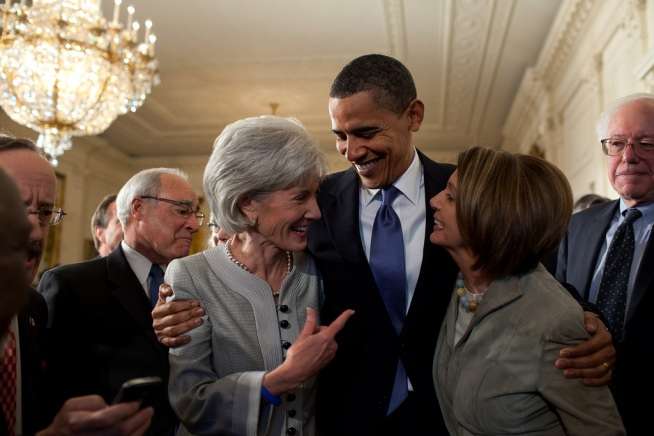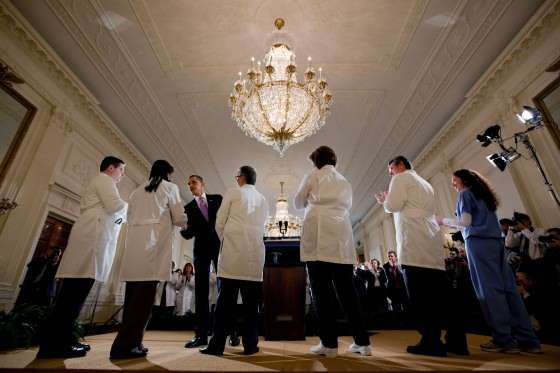The Obamacare Nightmare Scenario

At a congressional hearing yesterday with Gary Cohen, the Health and Human Services official charged with managing the implementation of Obamacare, Republican legislators charged that Cohen's agency may be improperly allowing some states to run "assister" programs that pay people to help individuals sign up for the health law's coverage options. Republicans charged that HHS may not have the statutory authority to fund those programs in states running their own exchanges. That includes states like California, which plans to use a significant part of the $910 million it has received so far in federal implementation grants to pay 21,000 such assisters $58 for each person successfully enrolled in new Obamacare coverage.
To most observers, this probably looked like a strictly technical dispute over the rules governing Obamacare's implementation funding. But at the heart of the dispute is something much larger—the growing liberal concern over what might be called the Obamacare Nightmare Scenario: that too few people, who are too sick, will sign up for coverage under the law, that premiums will rise in the exchanges, and that this will reinforce public skepticism of the law as an unworkable burden whose primary effect is to cause costs to rise.
You don't need to read between the lines to see this fear creeping into the left's conversations about the law.
You can see it in former White House health adviser Ezekiel Emanuel's recent Wall Street Journal op-ed, which warned that enrollment efforts needed more attention, because there's no certainty about how many people will sign up for coverage under the law. "This uncertainty," he wrote, "could set off a negative reinforcing cycle that undermines the entire exchange system."
You can see it in Kathleen Sebelius calls to insurers, to friendly foundations, and to tax prep organizations asking them to "support" Enroll America, a nonprofit that is practically an extension of the administration—it's led by a former Obama administration health official, and its entire mission is to sign people up for the new health law.
You can see it in the anxiety over California's enrollment promotion. As The L.A. Times reported last year, "federal officials have a lot riding on the California effort," which will be "an important test" of Obamacare in the face of GOP opposition. But it all "depends on getting enough people — healthy and unhealthy, uninsured and insured — to enroll. If that doesn't happen, the state could lose billions in federal dollars and insurance premiums could soar." The piece says that California authorities expect to enroll 2 million people in private insurance through the law, and describes the challenge of getting people to enroll as "daunting."

They're right to worry. In part because, as Emanuel notes in his piece, this sort of enrollment push has never been tried at this scale. But also because a version of what they worry about—low enrollment, an unusually sick population, and spiraling costs—has happened before, in Obamacare's first, smaller-scale attempt to expand coverage to the uninsured.
For the period between when the health law was passed and when its major coverage expansion kicked in, Obamacare set up a stopgap option for hard-to-insure individuals with troubled health history—the Preexisting Condition Insurance Plan (PCIP). The initial worry with this program, one I shared, was that it would go over budget as a result of high enrollment.
That concern was half right. Somewhere between 350,000 and 400,000 people were expected to enroll in the program. Instead, just 135,000 signed up—and then only after the administration went on an aggressive enrollment push. Yet even as The New York Times reported this week, even with far lower than expected enrollment, the cost of claims in the program has "far exceeded White House estimates, exhausting most of the $5 billion" the legislation provided to fund the program.
It wasn't just that too few people signed up. It was that the people who did sign up were, on average, very sick. And thus, very expensive to cover.
Which left states with very costly programs helping very few people: Last year Alaska said that its PCIP would cost $10 million in 2012—and cover just 50 people. New Hampshire enrolled just 80 people in its program, but spent twice its allotted federal funding. California had the highest enrollment of any state in the nation, but per-beneficiary costs came in three times higher than expected.
And what is the administration doing in response? Cutting payment rates to providers in order to hold costs down.
This could be Obamacare's future: Not a broad middle class benefit, but an expensive program with low enrollment that mainly covers the very sick and serves as a catalyst for driving doctor reimbursements down. Granted, this is far from the only possible future for the law, and far from the only way it could go wrong. But right now, I suspect, it's the disaster scenario that many liberal supporters of the health law fear the most.


Show Comments (108)